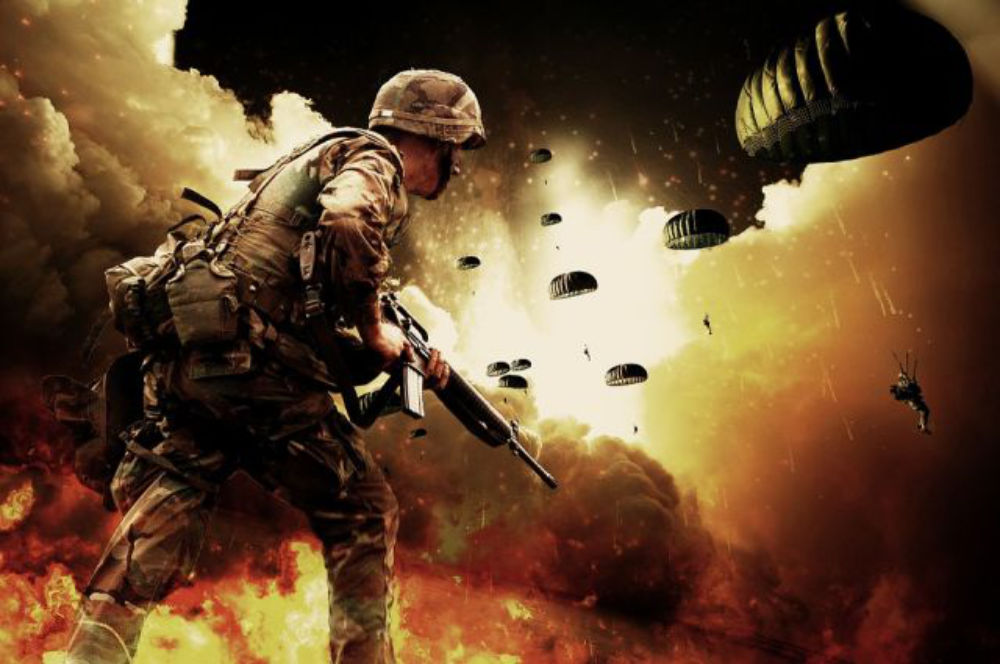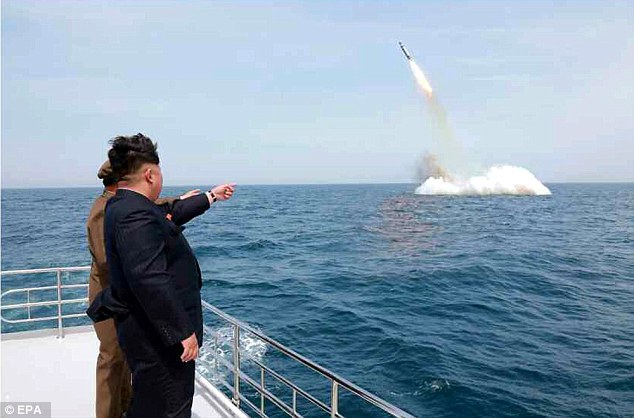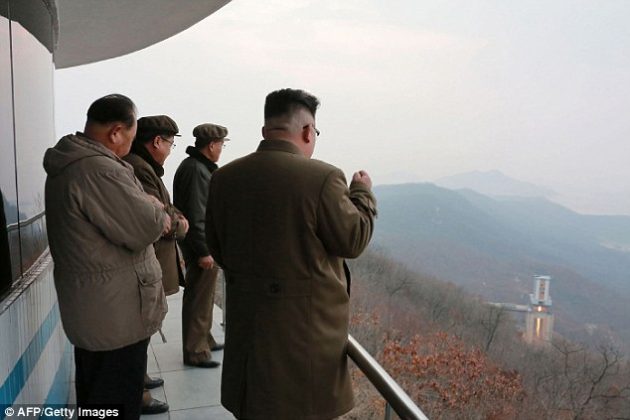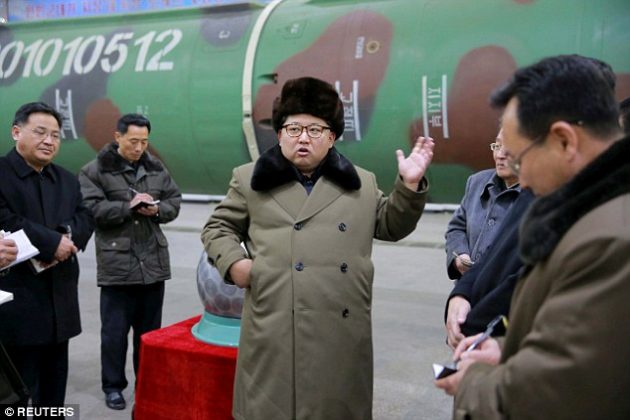Normally each year around this time there is an increase in tensions between North Korea, Japan, the United States, and South Korea; but this year, the tension is far worse, and the missile tests are far more.
North Korea is about to begin testing a nuclear weapon, warns South Korea. Last year, Kim Jong Un stated that they had mastered the ability to mount a warhead on a ballistic missile. The North, last year claimed that they had successfully carried out a nuclear test at the same site last January.
However, their latest missile test, on Wednesday, blew up in their faces, literally, just seconds after launch the US and South Korea reported that the test had failed. The missile was aimed at Japan; previously other ‘tests’ had landed 200 nautical miles off the coast of Japan. Newly added to the list of concerned countries regarding North Korea is Russia, who moved a satellite into the region to monitor the situation.
Rex Tillerson, the US Secretary of State, stated that the US days of strategic patience are over and that a preemptive strike was on the table. The end goal of Tillerson’s plan is to move North Korea into a different stance, one that involves dialogue with the West.
After failing a previous missile attempt, now North Korea wants to attempt a Hydrogen bomb test at the Punggye-Ri site. According to a South Korean Official; ‘North Korea is ready to carry out a nuclear test at any time, depending on the leadership’s decision. We are keeping a close eye on its nuclear activities,’ the official said.
Another official speaking to Fox News said; “The test could come as early as the end of the month,” said one official.
According to Fox News, North Korea is in the final stages of preparing for another Nuclear test, this would make five tests so far, the first being in 2006, that coupled with several other missile tests throughout recent weeks.
North Korea’s provocative tone is not new, it happens each year, several times a year, especially during February through April because of a Western joint military drill that is carried out in the region. However, with a new administration, Trump, in power in the West, it is evident that red lines may mean something again.
North Korea is directly connected to China, meaning that what the North does, China approves of, if a strike against our forces takes place, China warranted it. This is why the Korean crisis is such a concern. Never before has the tension been so high between the countries involved. Reason being, an inevitable discord between China and the USA has already begun to take shape this year.
Several points of tension between China and the USA are prevalent, such as with trade, monetary policy, and political dominance. Stark concerns are surrounding the reality that a trade war could strike upon the arrival of Trump’s multilateral policies.
Also previously, propaganda from North Korea was also just released, the video depicted Kim Jong Un striking US forces.
[fvplayer src=”https://player.vimeo.com/external/209363971.sd.mp4?s=a191865d06741b753d73b2220ca6285b84aa972f&profile_id=164″ splash=”https://christianjournal.net/wp-content/uploads/2017/03/209363971.jpg”]
The crisis in the region could quickly escalate into a much larger conflict between Super Powers, that could unmistakably lead to the inevitable World War Three. Other discords in the area are in regards to the South China Sea, where the communist nation of China has attempted to build up artificial islands for military purposes. The US has historically rejected the policies of China over the South China Sea, which has lead to an increase in tension between the two nations.
According to a China premier on a recent trip to Australia, who spoke with the Australian Broadcasting Corporation; “China’s visiting Premier has dismissed suggestions his nation is “militarizing” the waters of the South China Sea, but has acknowledged defense equipment placed on disputed islands was to help maintain “freedom of navigation.” Also, “With respect to the so-called militarization, China never has any intention to engage in militarization in the South China Sea,” Mr Li told reporters through an interpreter.
Several other, smaller countries, such as Japan, the Philippines, and Vietnam that surround the South China Sea have voiced their opinions about the communist nation’s advancement in the region.
Japan for instance, recently completed its second helicopter carrier, the Kaga, Wednesday, sending a message of military strength to China amid growing conflict over the South China Sea and other strategic waterways in Asia.
Japan wasn’t shy about its motivation. Vice Minister of Defense Takayuki Kobayashi said at the ceremony Tokyo was deeply concerned about China’s construction of islands and military bases in the South China Sea waterway, which is claimed by multiple Asian nations.
“China is attempting to make changes in the South China Sea with bases, and through acts that exert pressure is altering the status quo, raising security concerns among the international community,” he said.
Roughly, five trillion dollars worth of trade each year travels through the South China Sea, and several nations in the region utilize the waterways of the South China Sea especially the US and Japan, so the militarization attempt by China is a stark reason for concern in the region.
But, according to James ‘Mad Dog’ Mattis; The US defense secretary sees no need for a dramatic military action in the South China Sea.
The Bible describes the period we are living in as wars and rumors of wars, and the division among nations currently, is far greater than during the times of the World Wars.
Works Cited
Julian Robinson. “Will North Korea test a 'HYDROGEN BOMB' in 'a few days'? Officials warn Kim is set to order fresh nuclear test imminently.” DailyMail. . (2017): . .
Robert L. Gallucci. “Op-Ed If we're going to rule out negotiations with North Korea, we have to be ready for war.” LA Times. . (2017): . .
Lucas Tomlinson, Jennifer Griffin. “North Korea will launch another nuclear test in next few days, officials say.” Fox News. . (2017): . .
Defense reporter Andrew Greene. “China dismisses 'militarisation' of disputed islands in South China Sea.” ABC Australia. . (2017): . .
CRISTINA SILVA. “GROWING CONFLICT IN ASIA SPARKS MILITARY EXPANSION IN JAPAN.” Newsweek. . (2017): . .
Reporting by Manuel Mogato; Editing by Andrew Roche. “Philippines to strengthen military facilities in South China Sea.” Reuters. . (2017): . .







![[VIDEO] Drag Queen Drag Shows Are Now Infesting Churches](https://christianjournal.net/wp-content/uploads/2019/11/Screenshot-2019-11-22-at-9.02.01-PM-218x150.png)
![[VIDEO] Starbucks Worker Dumps Milkshake On Open Air Preachers Head](https://christianjournal.net/wp-content/uploads/2019/11/Screenshot-2019-11-22-at-7.23.43-PM-218x150.png)
![[VIDEO] Man Arrested For Threatening To Kill Female Abolitionist With Crowbar](https://christianjournal.net/wp-content/uploads/2019/11/MLock-1-218x150.jpg)
![[VIDEO] Drag Queen Drag Shows Are Now Infesting Churches](https://christianjournal.net/wp-content/uploads/2019/11/Screenshot-2019-11-22-at-9.02.01-PM-100x70.png)
![[VIDEO] Starbucks Worker Dumps Milkshake On Open Air Preachers Head](https://christianjournal.net/wp-content/uploads/2019/11/Screenshot-2019-11-22-at-7.23.43-PM-100x70.png)
![[VIDEO] Man Arrested For Threatening To Kill Female Abolitionist With Crowbar](https://christianjournal.net/wp-content/uploads/2019/11/MLock-1-100x70.jpg)


